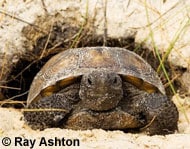Description:
The gopher tortoise is only one of three species of tortoises that are true burrowers with the Bolson’s tortoise and the African spurred tortoise being the others. Gopher tortoise burrows have one opening and go down to the ground water table where the tortoise lives in the cool high humidity. The gopher tortoise burrow can be more than 50 feet long, but most are 15 to 18 feet long. The width of the gopher tortoise burrow is just a bit wider than the length of the tortoise that dug it (so it can turn around). To keep a gopher tortoise in captivity one should provide an artificial burrow where the tortoise can maintain temperatures in the 70’s and relative humidity in the 80 percent range. The gopher tortoise burrow only needs to be a full arm’s length if built right. However people have raised gopher tortoises in their houses without burrows. Gopher tortoises lay eggs usually only once a year and have five to eight eggs in a nest. Gopher tortoise eggs hatch between 60 to 90 days at 88 degrees Fahrenheit. Young gopher tortoises grow fast when fed a good diet. Gopher tortoises become sub-adult in about six years and adult at 8 years for males and 17 to 20 years for females. Gopher tortoises are known to eat more than 1,000 species of plants through their range and more than 200 species in any one habitat. About 80 percent of their diet (after the hatchling size) is made up of grasses. Most yard grasses like bahia, centipede, St. Augustine, and blue grass are a good source of food for the gopher tortoise and many other tortoises. Grasses should be supplemented with just about every green leafy vegetable that is available. Gopher tortoises also like beans, corn and most fruits. Gopher tortoises love dandelions, narrow and broad leaf plantains, and many other weeds of the yard and garden. Fruits should only be given to gopher tortoises on rare occasions. Proper, diverse forage is one of the most important ways to stave off diseases, that and keeping other stresses down to a minimum. Like all other tortoises, gopher tortoises should be kept in outdoor pens with good lawns to forage from throughout the warmer months. Tortoises bask frequently and get their shell temperatures up to more than 90 degrees. Then they go out to feed, socialize and dig burrows. Gopher tortoises need to drink about every 8 days if they have a burrow and more frequently if they don’t. In the wild, gopher tortoises drink from rain pools or by sucking water from the edge of their burrow during heavy down pores. The gopher tortoise is protected throughout its range either by state or federal law. In Alabama, Mississippi, and Louisiana; it is a federally threatened species. Getting a permit to keep a gopher tortoise as a pet is very difficult. However, in the state of Florida, one can get a permit to keep individuals through the Florida Fish and Wildlife Conservation Commission. .
Habitat:
Southeastern United States along the Coastal plain as far north as southern S. Carolina, Georgia, all of Florida, southern Alabama, Mississippi and very southeastern Louisiana.
Range:
N/A
Scientific Name: Gopherus polyphemus
Species Group: tortoise
Family: N/A
Size: 10 to 12 inches. Largest recorded is 16 ¼ inches carapace length.
Level: intermediate
Weight: N/A
Dangerous: No


